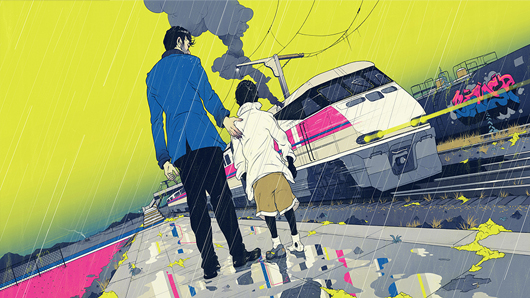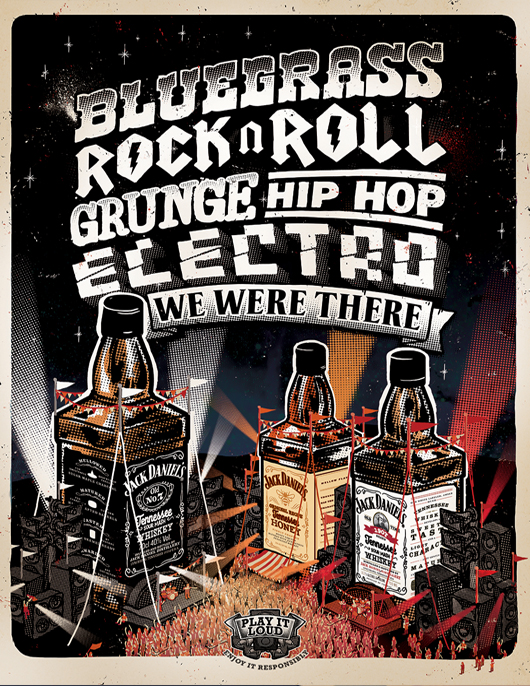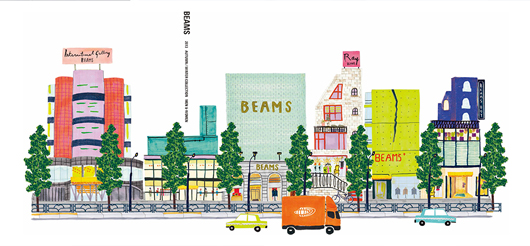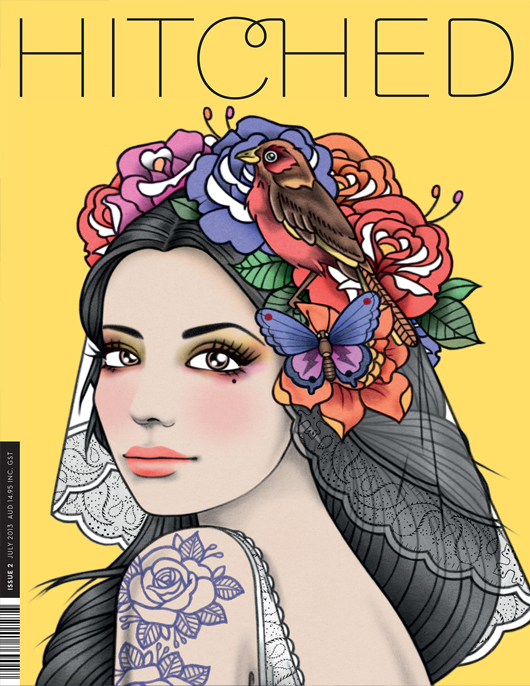The Jacky Winter Group
Jeremy Wortsman – Agent at The Jacky Winter Group

Illustration by Andrew Archer
What, for you and The Jacky Winter Group, do you look for in an illustrator before they become represented by you?
This is definitely the question I get the most, and in many ways the hardest to answer, as it’s often a strange brew of factors that come into account. The relationship aspect of representation is something that can not be overstated enough and like any healthy relationship, it can often involve compromise! I think Neil Gaiman summed it up best with his recent venn diagram of the perfect freelancer (http://neil-gaiman.tumblr.com/post/25016190500/batsandbones-my-venn-diagram-of-neil-gaimans) – I’m not sure how I could say it better myself, but it really is a mix of quality of work, level of professionalism, and personality fit.
Because of how we run as a business, we represent a larger number of artists than other agencies and furthermore we have specific branches in terms of how we manage those artists.
For a branch, such as The Hatch, which represents more emerging artists, these artists are mostly coming to us with their folios, fresh out of school, or after a career change and it’s more about being taken by their unique vision and hunger to succeed and develop.
For the other areas of the agency sometimes we might be looking to fill a particular gap in our offering and lately we have been taking a much more pro-active approach in finding artists and image makers that might not necessarily fall under traditional ‘illustration’.
The Australian market is quite unique in this way, in that we don’t have the same degree programs and BFA degrees that are putting hundreds of illustrators into the market each year, so we are really enjoying taking this new proactive approach.
At the end of the day, one of the most important things is working with artists and studios who understand the value of what we bring to the table. With some, especially those who haven’t worked very long, this involves a bit of an education in terms of the how and why we exist. For others it’s a relief to have us on board. In any case, it’s a platform of mutual respect. Our respect for our artists work and practice, and our artists respect for our talents and achievements. It’s worked out well so far!

Illustration by Andrew Fairclough
What would you advise an illustrator to do to get their portfolio commission friendly?
Again, I think this is entirely dependent on the illustrator and their goals. One of the things I love about illustration is the sheer number of specialties and niche industries that you can fit into. That said we do tend to cater primarily to ad agencies and publishers, so there are some things that we suggest.
With reference material at the fingertips of each commissioner, I think the most helpful thing is to have the broadest folio as possible as it relates to a particular aesthetic. If you are a specialist at realistic digital painting, there’s no need to show that one piece of vector art you did. We like having those things on file in the back-end, but there are definitely different approaches we take for an online folio vs a print folio, or a specific promo.
Furthermore to that broad range, you really want your folio to open up something in the mind of commissioners. Most art buyers and art directors are very time poor, and in some cases, can be quite risk-adverse. Our job as agents is really getting them over the line. If you are a fashion illustrator and immensely talented at drawing from life, but only have illustrations of models in your folio, it’s going to be difficult to convince a client that you can draw a still life of fruit, even if we know you can.
Finally, for a portfolio I do like to show work out of context in most cases. I want to show off your work, and not the work of the art director. This does have exceptions of course, but if you did a great spot illustration for a magazine, there’s no need to see the entire page layout.
Overall, we take a different approach to each illustrator, and the way one agency might do it, can be completely different to another. I don’t think there’s a right or wrong way, but there’s definitely a difference into being commission friendly as a freelancer on your own site, to being commission friendly on the site of an agent.

Illustration by Erian Chapman
Are there any trends in illustration this year that you see storming the scene?
I wouldn’t say that anything stands out in particular, but there are definitely more subtle shifts that we are noticing. I could probably write a whole essay about this, but I think that the artists we represent, especially in the new wave of people we are bringing on board later this month, represents some of the more exciting changes in aesthetic and tone that we are seeing in Australia.
One of the biggest changes that I see is really moving away from the confines that the term ‘illustration’ can sometimes bring to our industry. While I have a great respect for the term, and thing that in many ways that our craft is timeless, I think that because commissioners have such a broader access to talent on a global scale, that we are finding that certain jobs which would traditionally be in the realm of illustration are expanding quite rapidly beyond those borders. In advertising especially, where new mediums of engagement are being developed every day, we are finding that our role as agents are really changing into that more of as creative partners with our clients, and that our represented talent are in turn broadening their own skill sets in new and surprising ways.
This new area of image making, as I like to refer to it, really is where we are finding new veins of talent and therefore enabling us to grow our established offerings to our clients. In recent briefs we’ve engaged specialists such as architectural drafts people and 3D Printers to Signpainters and Data Visualisers. I think we’re in a golden age in some ways, and it’s an exciting time to be in the industry, no matter what you call yourself!

Illustration by Grace Lee
How important is an illustrators personal work to their commission work for The Jacky Winter Group?
From a marketing perspective I think it’s essential but from a folio perspective a bit less so. The one piece of advice that I give to new illustrators in terms of reaching their potential audience is to engage in self-initiated work. It’s something I strongly believe in and it’s how I got my foot in the door myself. If I had to look at the single quality that defines an artist who is able to transition from part-time illustration work, to being a full-time freelancer, it would be this. It’s surprising then that so little people take that advice or simply can’t come up with a good idea or something sustainable. I think in some ways this is good, is that it can really force you to confront your passion for the craft.
In the folio however, I still find in some cases that illustration can be a ‘riskier’ sell to clients, especially in advertising. Editorial it seems to be the opposite, so if that is your focus I would give different advice.
I also find this opposite to Photography. When we are talking to art buyers for SEA, our Photography branch, everyone only wants to see personal work. But for illustration, a few strong pieces commissioned work definitely seems to build that trust.

Illustration by Luke Lucas
Do you still find a certain value within showing clients a physical portfolio, or do you take the digital route?
Absolutely – Print is very much well and truly alive, and especially if you are presenting to a print publication, or an agency that does a large volume of print advertising, seeing the printed work on the page will always bring the work alive in a new way, and remains the most accessible way to have a casual and human conversation with someone in that environment.
That said, we always supplement our big books with other tools and like everything else it’s highly dependent on the situation in which you are presenting. Once you’ve done hundreds of meetings, you can easily read a room and know what the best setup or approach is going to be. As an agency, we are offering original creative content, and our marketing strategy should reflect that, therefore we’re always prepared to improvise accordingly. This is definitely part of a bigger conversation as it relates to marketing and promotion, however print definitely still has it’s place and requires just as much care and consideration, if not more, as it’s digital counterparts.

Illustration by Rik Lee
Has there been any styles within illustration that have really surprised you, whilst working at The Jacky Winter Group?
This is a tough one to answer! The element of surprise is something that I cherish very much, and I think in many ways it becomes evident in each commission. Regardless of how tight a brief is, or how much I work with an artist, each time I see a sketch start to take form it definitely gives me a bit of a high. As corny as it sounds as someone who never developed the talent to create new images myself, there’s definitely a bit of magic in the whole process, and I think that’s the most beautiful part of being an agent, is getting surprised multiple times each day!
Having began your own career within editorial design, how do you manage your time now working so actively with illustrators to creating your own work?
As the director of the business, the work is my work. As Andy Warhol said “Making money is art and working is art and good business is the best art”.
Back to News Page
